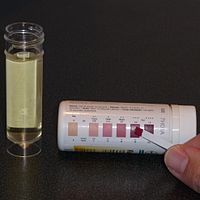
Photo from wikipedia
We investigated the single and combined effects of 2 feeding levels (normal lactation diet vs. energy-reduced diet, both fed for ad libitum intake) and 2 daily milking frequencies (twice vs.… Click to show full abstract
We investigated the single and combined effects of 2 feeding levels (normal lactation diet vs. energy-reduced diet, both fed for ad libitum intake) and 2 daily milking frequencies (twice vs. once) during 1 wk before the dry-off day (d 0), as well as an intramuscular injection of either a dopamine agonist (cabergoline; Velactis, Ceva Santé Animale; labeled for use only with abrupt dry-off, e.g., no reduction in feeding level or milking frequency before the last milking) or saline after the last milking on d 0 on the feeding motivation of clinically healthy, loose-housed, pregnant, lactating Holstein cows. From d 0, all cows were fed the same dry-cow diet for ad libitum intake. Cows were subjected to 2 feed-thwarting tests, a test in the home pen using their diets (test A: d -6, -1, and 1; during 35 min when the feed bins were filled, but locked) and another test carried out in an adjacent pen in which access to concentrate provided in a familiar plastic box was blocked by a wire-mesh lid (test B: d -5 and 2). In test A, we recorded how often cows attempted to feed per 35 min, whether cows vocalized during the 35-min period, and latency to feed within 300 s after feed bins were unlocked. In test B, we recorded latency to approach either of 2 familiar boxes (the wire-mesh box and an identical open box with a small portion of concentrate) within 600 s and how often cows directed behaviors toward the wire-mesh box (number of occurences/5 min). On d -6 (test A), no clear differences in feeding motivation among treatments were found. On d -5 and -1, cows fed the energy-reduced diet displayed a higher probability of vocalizing (test A), were more than 50% quicker to feed (test A), were approximately 5× quicker to approach a box (test B), and directed 60% more behavior toward the wire-mesh box (test B) than cows fed the normal diet. Moreover, cows fed the energy-reduced diet attempted to feed approximately 75% more on d -1 compared with d -6 (test A). On d 2 (test B), cows previously fed the normal diet directed 40% more behavior toward the wire-mesh box than cows previously fed the energy-reduced diet. Reducing feeding level, either before or on the dry-off day, resulted in consistently increased feeding motivation, interpreted as a sign of hunger. No clear effects of change in milking frequency, singly or combined with reduced diet energy density, on feeding motivation were found before d 0. Whereas, on d 2, cows previously milked twice daily were quicker to approach a box than cows previously milked once daily. Cows injected with cabergoline attempted to feed more, but showed lower probability of vocalizing compared with saline-injected cows (d 1; test A), irrespective of treatment before d 0. The effects of cabergoline on feeding motivation are not easily interpreted and warrant further investigation. From a hunger perspective, reducing milking frequency rather than diet energy density seems to be a less negative management to reduce milk production before dry-off.
Journal Title: Journal of dairy science
Year Published: 2021
Link to full text (if available)
Share on Social Media: Sign Up to like & get
recommendations!